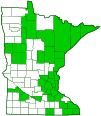Summer Oyster Mushroom
(Pleurotus pulmonarius)
Conservation • Description • Habitat • Ecology • Distribution • Taxonomy
Conservation Status |
|
|||||||
| IUCN Red List | not listed |
|||||||
| NatureServe | NNR - Unranked |
|||||||
| Minnesota | not listed |
|||||||
Description |
||
Summer Oyster Mushroom is a medium sized to large shelf-like fungus. It is known by several common names, including Phoenix Oyster, Pale Oyster, Lung Oyster, Indian Oyster, Italian Oyster, and in the UK, White Oyster Mushroom. iNaturalist uses the name Summer Oyster Mushroom, which refers to its appearance in the warm summer months. The “true” oyster, Oyster Mushroom (Pleurotus ostreatus), appears in the cool weather months of fall and early spring. Summer Oyster Mushroom occurs in Europe, in North and Central America, and less commonly in the temperate regions of Asia, Australia, and South America. In the United States it occurs east of the Great Plains, west of the Rocky Mountains, and in the mountainous areas of Colorado, Utah, Arizona, and New Mexico. In Minnesota it is common in the east, mostly absent in the west. It appears from late spring through September in shelf-like clusters on hardwoods, both on fallen logs of dead trees and on the trunks of living trees. In the western United States, it also grows on conifers. It obtains its nutrients from dead wood (saprobic), and it causes white rot in living trees. When it first appears the cap is convex, mostly hairless, and whitish to beige, or pale tan. It does not have dark brown areas. The surface is somewhat greasy, and the margins are rolled inward. As it ages it flattens out, the color fades, and the margins become lined and wavy. Mature caps are semicircular, fan-shaped, or lung-shaped. This is the feature that gives the fungus its specific epithet and one of its common names. They can be ¾″ to 8″ (2 to 20 cm) wide but are usually no more than 4¾″ (12 cm) wide. There is often a stem, though sometimes it is sometimes rudimentary, sometimes absent. When present, it is whitish, hairless, ⅜″ to 1½″ (1 to 4 cm) long, and 3⁄16″ to ⅜″ (5 to 10 mm) thick. It may be centered, off-center (eccentric), or at the side (lateral). The gills are whitish and run down the stalk. They sometimes become yellowish with age. They may be closely spaced or nearly widely spaced, and there are frequent short gills between the main gills. The flesh is thick and white. It does not discolor when sliced. It is edible and has a mild taste. The spore print is whitish, grayish, or lilac. |
||
Similar Species |
||
Oyster Mushroom (Pleurotus ostreatus) cap is usually larger and more brownish. The margin is never lined. There is usually no stem. It appears in the cool weather months of fall and early spring. |
||
Habitat and Hosts |
||
Dead hardwood logs and living hardwood tees |
||
Ecology |
||
Season |
||
late spring through September |
||
Distribution |
||||
|
Sources |
|||
| 10/13/2022 | ||||
Occurrence |
||||
Common |
||||
Taxonomy |
|||
| Kingdom | Fungi (Fungi) | ||
| Subkingdom | Dikarya | ||
| Phylum | Basidiomycota (Basidiomycete Fungi) | ||
| Subphylum | Agaricomycotina (Higher Basidiomycetes) | ||
| Class | Agaricomycetes (Mushrooms, Bracket Fungi, Puffballs, and Allies) | ||
| Subclass | Agaricomycetidae | ||
| Order | Agaricales (Common Gilled Mushrooms and Allies) | ||
| Suborder | Pleurotineae | ||
| Family | Pleurotaceae | ||
| Genus | Pleurotus (oyster mushrooms) | ||
The genus Pleurotus was formerly placed in the family Tricholomataceae. Molecular phylogenetic analysis resulted in several new families, including Pleurotaceae, being separated from Tricholomataceae by 2006. |
|||
Synonyms |
|||
Agaricus pulmonarius Dendrosarcus pulmonarius Pleurotus araucariicola |
|||
Common Names |
|||
Indian Oyster Italian Oyster Lung Oyster Pale Oyster Phoenix Oyster Summer Oyster Mushroom White Oyster Mushroom (UK) |
|||
Glossary
Saprobic
A term often used for saprotrophic fungi. Referring to fungi that obtain their nutrients from decayed organic matter.
Visitor Photos |
|||||
Share your photo of this fungus. |
|||||
| This button not working for you? Simply email us at info@MinnesotaSeasons.com. Attach one or more photos and, if you like, a caption. |
|||||
Margot Avey |
|||||
This tree had what looked like large globs of whipped cream all the way up the trunk! |
|||||
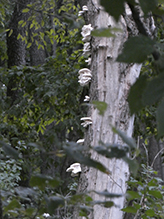 |
|||||
Honey Fae (Farah) |
|||||
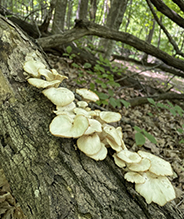 |
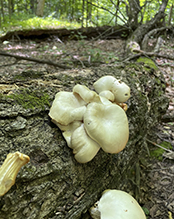 |
||||
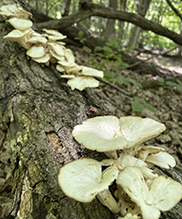 |
|||||
MinnesotaSeasons.com Photos |
|||||
|
|||||

Slideshows |
||

Visitor Videos |
|||
Share your video of this fungus. |
|||
| This button not working for you? Simply email us at info@MinnesotaSeasons.com. Attach a video, a YouTube link, or a cloud storage link. |
|||
Other Videos |
|||
| White Oyster Mushrooms, Pleurotus pulmonarius Wild Food in the UK Ltd |
|||
About
May 21, 2018 Identifying the White Oyster Mushroom - Pleurotus pulmonarius. See here for more info on the Oyster Mushrooms; hhttps://www.wildfooduk.com/mushroom-guide/oyster-mushroom/ |
|||
| Oyster (Pleurotus ostreatus-pulmonarius, Pleurotus populinus) mushrooms are fruiting abundantly now! Paul Stamets |
|||
About
May 7, 2020 Oyster (Pleurotus ostreatus-pulmonarius, Pleurotus populinus) mushrooms are fruiting abundantly now! They grace a wide range of hardwoods – including alders and birches (Betulaceae) as well as cottonwoods, poplars, aspens (Populaceae) – also maples and many other tree species, including conifers. They usually fruit both in the spring and fall, so when you find a spring fruiting, go back to that tree for another harvest in the fall. Delicate in flavor, but perishable, it is best to eat them within a day or two of collecting. Oyster mushrooms are some of the easiest to grow, and they adapt to a wide range of substrates, due to a prodigious production of enzymes for digesting cellulose. As such, they are premier species for bioremediation of chemical toxins (mycoremediation). A curious talent of oyster mushrooms is their ability to stun and consume nematodes. This is one avenue by which they accumulate and manufacture proteins. (Oyster mushrooms can have up to 20% protein.) And when they digest a substrate like wheat straw, about 20% of the mass becomes water. These mushrooms are water-makers! Of all the species that can be cultivated, oyster mushroom species stand out for fighting starvation, hydrating arid environments, breaking down toxins and is, in my judgment, a keystone species in the ecology of forests. But be forewarned: insects love them too! So do birds, squirrels, and the dreaded slug. Competition for this fungal food! For more information on the nutritional properties of mushrooms, including oysters, see my article “Notes on Nutritional Properties of Culinary–Medicinal Mushrooms” in International Journal of Medicinal Mushrooms, Vol. 7, pp. 103–110, 2005. Oyster mushrooms also contain cholesterol limiting compounds: “Investigation of Lovastatin, the Anti-hypercholesterolemia Drug Molecule from Three Oyster Mushroom Species. (Mani Ramakrishnan et al. 2017. International Journal of Biomedical and Clinical Sciences Vol. 2, No. 4, pp. 26-31, 2017, http://www.aiscience.org/journal/ijbcs) Oyster mushroom mycelium – upon exposure to blue light – produces shikimic acid, a precursor to the popular antiviral drug Tamiflu®: (Kojima, M et al. Regulation of Primary Metabolic Pathways in Oyster Mushroom Mycelia Induced by Blue Light Stimulation: Accumulation of Shikimic Acid. Sci. Rep. 5, 8630; 2015. DOI:10.1038/srep08630.) For more information on mycoremediation with oyster mushrooms, see Mycelium Running: How Mushrooms Can Help Save the World Ten Speed Press, Random House. |
|||
| What's So Special About Summer Oyster Mushrooms? Learn Your Land |
|||
About
Aug 11, 2017 Oyster mushrooms — especially the ones that grow in the summer months — are tasty. They're also extremely good for you. How so? Check out the video! |
|||
| Oyster mushrooms, Pleurotus pulmonarius, a delicious, edible mushroom. The Rush Room |
|||
About
Sep 30, 2021 Oyster mushrooms, Pleurotus pulmonarius, a delicious, edible mushroom. |
|||
| Summer Oyster Wild Mushrooms Pleurotus pulmonarius also called Phoenix Oyster ledburnerss |
|||
About
Jul 16, 2013 Summer Oyster Wild Mushrooms Pleurotus pulmonarius also called Phoenix Oyster Mild tasty flavor. I egged and bread crumbed and fried, YUMMY. fried and then added sunny side up eggs, and I stir fried and and loads! Easy to identify but always consult and expert. White spore print. Are you a mycophile? |
|||

Visitor Sightings |
|||||
Report a sighting of this fungus. |
|||||
| This button not working for you? Simply email us at info@MinnesotaSeasons.com. Be sure to include a location. |
|||||
| Margot Avey 9/9/2022 |
Location: St. Louis Park, MN This tree had what looked like large globs of whipped cream all the way up the trunk! |
||||
| Honey Fae (Farah) 7/25/2022 |
Location: Hennepin County |
|
|||
MinnesotaSeasons.com Sightings |
|||||
|
|||||

Created: 10/13/2022
Last Updated:
